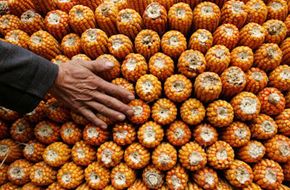Why are seed banks necessary?
Although you might think the concept is rooted in the contemporary "green" movement, seed banking is not a new phenomenon. Scientists believe agriculture began as far back as 8000 B.C., in the mountains of Mesopotamia, now present day Iraq. Even then, farmers realized their seeds needed protection in order to ensure the next year's harvest. As a result, seed harvesting was one of the most important rituals in ancient farming communities. In Iraq, scientists have discovered evidence of seed banks from as far back as 6750 B.C. [source: Seabrook].
Back then, seed banks protected seeds from animals and extreme weather. Today, we store seeds for different reasons. The most essential reason is crop diversity. Just as humans have specific genetic traits, so do plants. And just as humans have evolved and adapted to specific conditions over time, so have plants. Different varieties of plants are suited for different things. A good example is corn. Corn is grown in different parts of the world and in different climates, which creates many varieties of corn [source: Rosenthal].
Advertisement
This sort of diversity must be preserved -- not because we need 50 varieties of popcorn, but because we don't want to lose any plants that may prove valuable in the future. For example, in the 1970s a widespread fungus cut United States corn yields in half. The blight was alleviated by use of genetic materials from a wild corn relative that was fungus-resistant [source: WWF].
Aside from crop diversity, there are many other reasons we need to store and preserve seeds:
- Climate change: Scientists are concerned that climate change will cause extreme weather conditions and bring new pests into some environments. These events could cause certain species of plants to go extinct [source: Rosenthal].
- Natural disasters: Natural disasters can wreak havoc on a region's ecosystem. After the 2004 tsunami destroyed rice paddies in Malaysia and Sri Lanka, international seed banks provided local farmers with varieties of rice to begin growing their crops again [source: Roug].
- Disease: Disease quickly and easily wipes out crops. For example, a recent strain of disease called stem rust (Ug99) may have the capability to infect up to 25 percent of the world's wheat supply [source: Singh].
- Man-made disaster: Man-made disasters can be as devastating to plant life as natural disasters. An obvious example would be war. In fact, one of Iraq's vital seed banks was looted during fighting [source: Pearce].
- Research: Indigenous people have used plants to cure sickness for centuries. One in every six wild plants is used for medicinal purposes [source: Levine]. Who knows what diseases the right plant or herb could eradicate?
Now that we understand why seed banks are necessary, let's learn which seeds get banked. Are all plants guaranteed a spot in the seed bank or are some deliberately shunned? Read the next page to find out.
